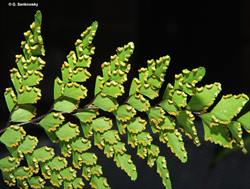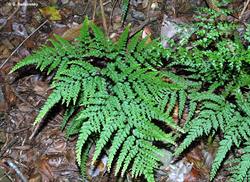Pteridaceae
Australian Tropical Ferns and Lycophytes - Online edition
Adiantum formosum




Adiantum formosum R.Br.
Link to Australian Plant Name Index for publication details and synonyms: https://id.biodiversity.org.au/name/apni/76453
Maidenhair Fern
Rhizome long-creeping, much-branched, to 10 mm diam.; scales concolorous, golden brown, with an acuminate apex and blunt marginal teeth. Fronds scattered, to 180 cm long. Stipe to 90 cm long, dull and scabrous proximally, glossy and minutely tuberculate distally. Lamina 2–4-pinnate, triangular to pentagonal, 15–100 cm long, 15–90 cm wide, stiffly herbaceous to subcoriaceous; rachises and pinna stalks clothed adaxially with dense antrorse red-brown hairs. Higher order segments (except pinnules) elliptic or triangular. Primary pinnae progressively reducing in length and degree of branching from base to apex. Pinnules symmetric and flabellate or dimidiate and rectangular to trapeziform, glabrous or sparsely clothed abaxially with pale erect hairs; distal margins irregularly lobed, dentate when sterile. Sori 1–10 along distal margins, 1 or 2 per lobe; soral flaps lunate to subreniform, glabrous. Spores 64 per sporangium, golden yellow; perine scabrous, loosely adhering to exine; largest diam. (29–) 33 (–36) µm.
Endemic to E and SE
Terrestrial in loam or gravelly soil in simple notophyll vine forest or wet sclerophyll forest.
A commonly cultivated ornamental fern. It can be invasive in some garden situations.
This is a commonly cultivated ornamental fern in tropical, subtropical and temperate areas. It is suited to growing in the ground in a shadehouse or in a shaded and moist part of the garden. It can become invasive in some situations and spreads via its deep underground rhizome.
Key to some Adiantum species of tropical
1a. Fronds pinnate = Adiantum philippense
1b. Fronds bipinnate or higher = 2
2a. Pinnules flabellate to rounded = 3
2b. Pinnules obliquely oblong to rhomboid = 5
3a. Soral flaps broadly attached to lamina and situated on the ends of lobes with incisions between them = Adiantum capillus-veneris
3b. Soral flaps reniform and narrowly attached to lamina and situated in incisions of the lamina margin with lobes between them = 4
4a. Rhizome long creeping, rhizome scales translucent with entire margins, plants stoloniferous and spreading, pinnae pale bright green when mature = Adiantum aethiopicum
4b. Rhizome short creeping, rhizome scales opaque with denitculate margins, not stoloniferous plants tufted, pinnae dark green when mature = Adiantum atroviride
5a. Rhizome long creeping, fronds scattered = 6
5b. Rhizome not long creeping, fronds tufted = 7
6a. Primary pinnae progressively reducing in length from base to apex of frond resulting in a triangular lamina = Adiantum formosum
6b. Primary pinnae equal in length resulting in an ovate lamina = Adiantum silvaticum
7a. Pinnae soft and membraneous with fine black hairs on the undersurface, root tubers present, often proliferous, stipe smooth = Adiantum diaphanum
7b. Pinnae herbaceous to coreaceous with white hairs, root tubers absent, not proliferous, stipe not smooth = Adiantum hispidulum
Field AR, Quinn CJ, Zich FA (2022) Australian Tropical Ferns and Lycophytes. apps.lucidcentral.org/fern/text/intro/index.htm (accessed online INSERT DATE).
Field AR, Quinn CJ, Zich FA (2022) ‘Platycerium superbum’, in Australian Tropical Ferns and Lycophytes. apps.lucidcentral.org/fern/text/entities/platycerium_superbum.htm (accessed online INSERT DATE).







